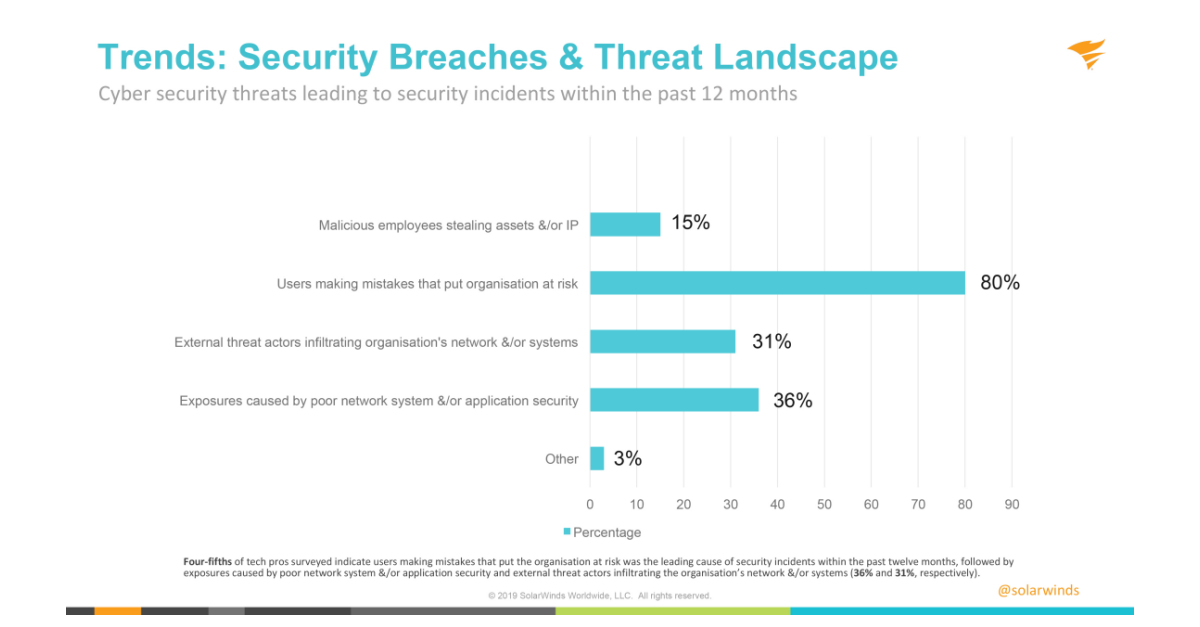SolarWinds Research Reveals Negligent Users as Top Cybersecurity Threat to German Organisations
SolarWinds Research Reveals Negligent Users as Top Cybersecurity Threat to German Organisations
SolarWinds Research Reveals Negligent Users as Top Cybersecurity Threat to German Organisations
SolarWinds (NYSE:SWI), a leading provider of powerful and affordable IT management software, today released findings of its latest cybersecurity resea
SolarWinds Research Reveals Negligent Users as Top Cybersecurity Threat to German Organisations
Key Findings
Threat Trends: Internal Users Put Organisations at Risk
Types of cybersecurity threats leading to security incidents within the past 12 months:
- Out of a variety of security incidents, 80% of respondents attributed the largest portion of cybersecurity threats to internal users making mistakes, while 31% attributed at least a portion to external threat actors; followed by 36% that indicated exposures caused by poor network system and/or application security have led to security incidents.
- 70% indicated regular employees are the users who pose the biggest risk for insider abuse and/or misuse, followed by privileged IT administrators and executives (45% and 33%, respectively).
- 45% named poor password management as the most common cause of accidental/careless insider breaches from employees and contractors, while 42% of tech pros surveyed state that sharing passwords is the most common cause, followed by accidentally exposing, deleting, corrupting, and/or modifying critical data and copying data to unsecured devices (40% and 36%, respectively).
The following cybersecurity threats could lead to security incidents in the next 12 months:
- 55% of respondents are extremely concerned or moderately concerned (combined) about internal users making mistakes that put organisations at risk. This is followed by 50% and 42% indicating exposure caused by poor network system and/or system security and external threat actors infiltrating their organisation’s network and/or systems as the top concerns, respectively.
- Nearly half of tech pros surveyed are extremely concerned or moderately concerned (combined) that cybercriminals will lead to security incidents in the next twelve months, while one-third of tech pros feel the same about cyberterrorists—and one-fifth of tech pros indicating nation-state actors as top concerns within the same timeframe.
IT Skillsets and Landscape: Not Sufficiently Equipped
- 89% of tech pros feel unequipped to successfully implement and manage cybersecurity tasks today given their current IT skillset, while over half of tech pros surveyed (54%) feel unequipped to utilize predictive analytics to determine the likelihood of outcomes in their architecture.
- One-fourth of tech pros feel the most significant barrier to maintaining and improving IT security within their organisation is the complexity of their IT infrastructure, followed by budget constraints (20%), and lack of manpower (19%).
- 45% of tech pros surveyed have adopted a hybrid approach to their IT security, protecting and managing the security of their own network but also using a managed provider to deliver some security services—while 43% are self-managed and 6% outsource entirely.
Top Security Technologies
- Top technologies used by technology professionals according to respondents include:
- Detection:
- Access rights management (64%)
- IDS and/ or IPS (48%)
- Vulnerability assessment (38%)
- Protection:
- Email security (77%)
- Data encryption (70%)
- Endpoint protection (65%)
- Patch management (65%)
- Risk management:
- Identity governance (58%)
- Asset management (55%)
- Governance, risk, and compliance (GRC) (45%)
- Response and recovery:
- Backup and recovery (70%)
- Access rights management (50%)
- Incident response (37%)
The findings are based on a survey fielded in August/September 2019, which yielded responses from 110 technology practitioners, managers, and directors in Germany from public- and private-sector small, mid-size and enterprise organisations.

